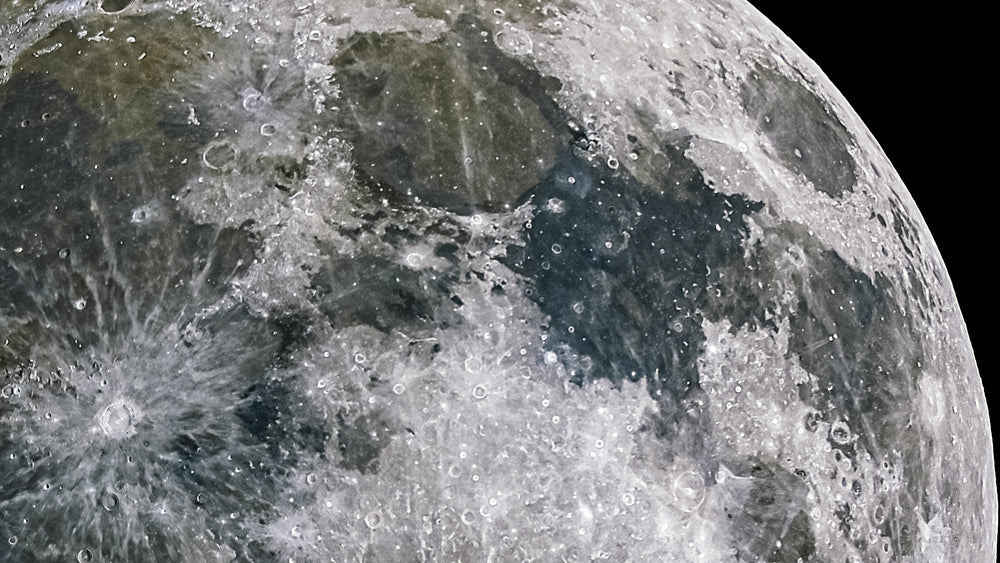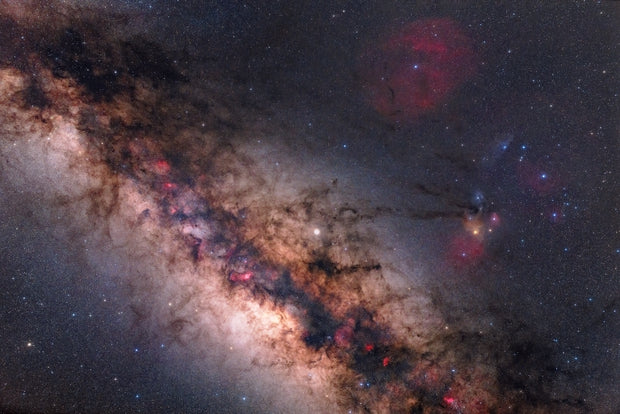Planetary and lunar photography can be one of the most exciting and rewarding experiences for any astrophotographer. With the right equipment, you can capture stunning images of our moon, and the other planets in our solar system. But to do this, you'll need the right camera. In this article, we'll explore the best planetary and lunar cameras on the market, and what to look for when choosing one.
Why use a dedicated planetary camera?
While many DSLRs and mirrorless cameras can capture decent images of the moon and planets, dedicated planetary cameras are designed specifically for this task. They often have smaller sensors, faster frame rates, and higher magnification capabilities, making them ideal for capturing detailed and sharp images of planets and our moon.

What to look for in a planetary camera
When choosing a planetary camera, there are a few key features to consider:
- Sensor size: Generally, the larger the sensor, the better the image quality. However, larger sensors also tend to be more expensive. Look for a sensor that is at least 1/2.3 inches in size.
- Frame rate: The higher the frame rate, the more images you can capture per second. This is important when trying to capture sharp images of planets and our moon. Look for a camera that can capture at least 30 frames per second.
- Resolution: Higher resolutions allow for greater detail and clarity in your images. Look for a camera with a resolution of at least 1280 x 720 pixels.
- Compatibility: Make sure the camera is compatible with your telescope or other equipment.
Best planetary and lunar cameras
Here are some of the best planetary and lunar cameras on the market:
- ZWO ASI290MM Mini: This camera has a 1/2.8-inch sensor and can capture up to 170 frames per second. It also has a high resolution of 1936 x 1096 pixels.
- Celestron NexImage 10: This camera has a larger 1/1.25-inch sensor and can capture up to 28 frames per second. It has a resolution of 1280 x 720 pixels.
- QHY5III178M: This camera has a 1/1.8-inch sensor and can capture up to 60 frames per second. It has a high resolution of 3072 x 2048 pixels.
- Altair GPCAM3 290C: This camera has a 1/3-inch sensor and can capture up to 160 frames per second. It has a resolution of 640 x 480 pixels.
Top Planetary and Lunar Cameras on the Market
Now that you have a good understanding of the features and considerations to keep in mind when choosing a planetary or lunar camera, let's take a look at some of the top cameras currently on the market.
ZWO ASI224MC
The ZWO ASI224MC is a popular choice among planetary photographers, thanks to its high sensitivity and low noise levels. It features a 1/3" CMOS sensor with a resolution of 1.2 MP, and can capture images at up to 150 frames per second. The camera also comes with a user-friendly software package that allows you to adjust settings like exposure, gain, and white balance. At a price point of around $350, the ZWO ASI224MC is a great choice for amateur and intermediate astrophotographers.
Celestron NexImage 10
The Celestron NexImage 10 is another popular choice for planetary photography, thanks to its high-resolution sensor and ease of use. The camera features a 1/2.5" CMOS sensor with a resolution of 10.3 MP, and can capture images at up to 60 frames per second. It also comes with Celestron's iCap software, which allows you to adjust settings like exposure time, gain, and white balance. The NexImage 10 is a bit more expensive than the ZWO ASI224MC, with a price point of around $400, but its high resolution and ease of use make it a great choice for intermediate and advanced astrophotographers.
QHY5III 290M
The QHY5III 290M is a popular choice among professional astrophotographers, thanks to its high sensitivity and low noise levels. The camera features a 1/3" CMOS sensor with a resolution of 2.1 MP, and can capture images at up to 280 frames per second. It also comes with a user-friendly software package that allows you to adjust settings like exposure, gain, and white balance. The QHY5III 290M is a bit more expensive than the previous two cameras, with a price point of around $500, but its high sensitivity and low noise levels make it a great choice for professional astrophotographers.
ZWO ASI174MM
The ZWO ASI174MM is another popular choice among professional astrophotographers, thanks to its high resolution and sensitivity. The camera features a 1/1.2" CMOS sensor with a resolution of 2.3 MP, and can capture images at up to 164 frames per second. It also comes with a user-friendly software package that allows you to adjust settings like exposure, gain, and white balance. The ASI174MM is a bit more expensive than the QHY5III 290M, with a price point of around $700, but its high resolution and sensitivity make it a great choice for professional astrophotographers who demand the best image quality.
Other considerations
Aside from the features listed above, there are a few other considerations to keep in mind when choosing a planetary camera:
- Price: Planetary cameras can range from a few hundred to several thousand dollars. Consider your budget and choose a camera that fits within it.
- Portability: If you plan on traveling to different locations to capture images, consider a camera that is lightweight and easy to transport.
- Software: Many planetary cameras come with software that allows you to control the camera and adjust settings. Make sure the software is user-friendly and compatible with your computer.
- Accessories: Some cameras may require additional accessories, such as filters, to capture the best images. Make sure to research what accessories you may need before making a purchase.
Tips for capturing great images
Once you have your planetary camera and other equipment, there are a few tips to keep in mind when capturing images:
- Use a stable mount: A stable mount is crucial for capturing sharp and detailed images. Consider investing in a sturdy tripod or mount.
- Shoot during optimal conditions: Planetary and lunar photography is best done when the sky is clear and stable. Check the weather forecast and plan your shoot accordingly.
- Experiment with settings: Different cameras and conditions may require different settings. Don't be afraid to experiment with settings like exposure time and gain.
- Post-processing: Post-processing can enhance the details and colors in your images. Consider using software like RegiStax or AutoStakkert to stack and process your images.
Additional Tips and Resources
To help you get started with planetary and lunar photography, here are some additional tips and resources to consider:
- Use a telescope with a long focal length: To capture high-resolution images of the moon and planets, you'll need a telescope with a long focal length. The longer the focal length, the larger the image scale and the more detail you'll be able to capture. A telescope with a focal length of at least 1000mm is recommended for planetary and lunar photography.
- Use a high-quality barlow lens: A barlow lens can effectively double the effective focal length of your telescope, allowing you to achieve higher magnifications and capture more detail. Look for a high-quality barlow lens with a clear aperture of at least 1.25".
- Consider using a filter: Filters can help improve contrast and reduce glare when photographing bright objects like the moon and planets. A color filter can help enhance certain features, while a neutral density filter can help reduce glare and prevent overexposure.
- Join an astrophotography community: Joining a community of astrophotographers can provide valuable support, advice, and inspiration. Consider joining an online forum, social media group, or local astronomy club to connect with other enthusiasts and share your work.
- Experiment with different techniques: There is no one "right" way to capture planetary and lunar images, so don't be afraid to experiment with different techniques and settings. Try adjusting your exposure time, ISO, and gain to see how they affect your images, and don't be afraid to try stacking multiple images together for improved detail and clarity.
- Learn from experts: There are many resources available online that can help you improve your planetary and lunar photography skills. Check out YouTube channels like AstroBackyard, which offers tutorials and reviews of astrophotography equipment, or websites like The Planetary Society, which provides information and resources on planetary exploration and imaging.
Conclusion
Capturing stunning images of our moon and the planets in our solar system can be a rewarding and exciting experience. With the right camera, you can capture images that are truly out of this world. When choosing a planetary camera, consider the sensor size, frame rate, resolution, and compatibility with your other equipment. The cameras listed above are some of the best on the market, but there are many other options available. Whatever camera you choose, make sure to have fun and enjoy the wonders of our universe!
More Camera Topics:
- When Was the Camera Invented?
- Who Invented The Camera?
- What is ISO in Photography
- Astronomy Camera Color or Mono
- Mirrorless Camera vs DSLR
- Canon M50 Review
- Nikon D5600 Review
- Canon EOS R6 Review
- Best Lens for Astrophotography Canon
- Best Lens for Astrophotography Nikon
- Best Lens for Astrophotography Sony A7iii
- Best Lens for Astrophotography Fujifilm
- Best Lenses for Astrophotography
- Best Camera for Astrophotography
- Astrophotography Camera Settings



